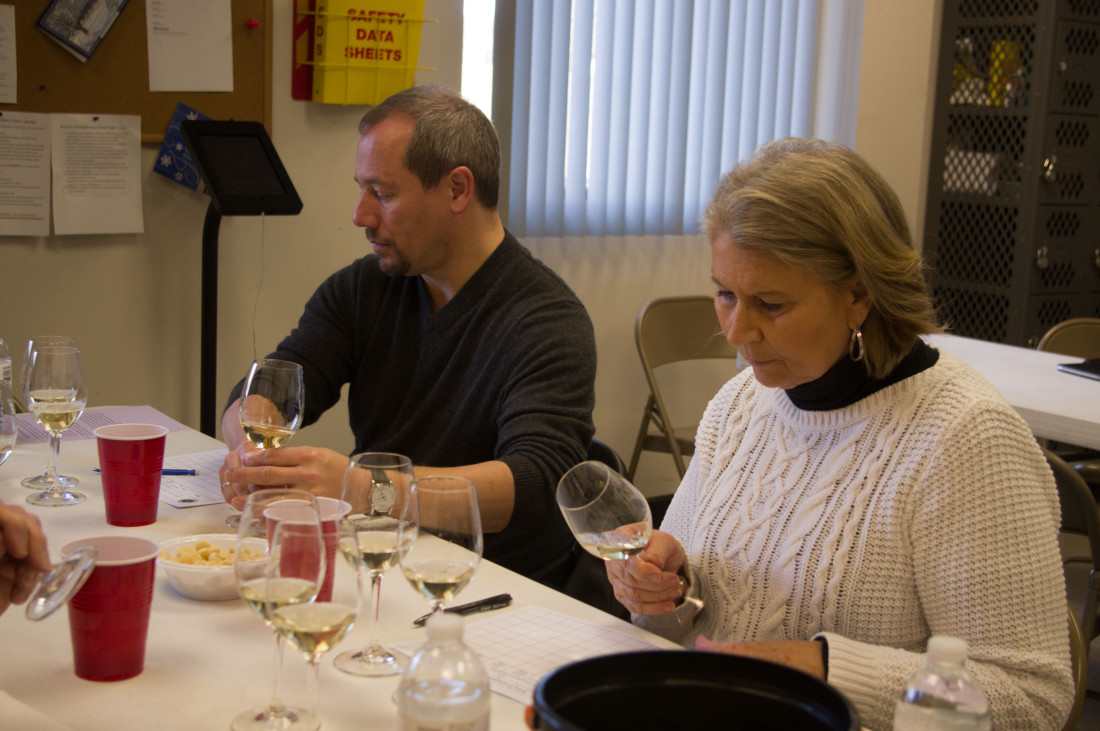In 1976, the famed Judgment of Paris set off waves of change that forever altered the way the world drinks wine. British wine merchant Steven Spurrier organized the blind tasting, where remote California winemakers presented their humble and often scoffed-at Napa Valley wines alongside stalwart French vintages before a panel of 11 sommeliers and wine judges. To everyone’s shock and bewilderment, California’s Stag’s Leap Cellars took top honors ahead of France’s Montrose, Mouton and Haut Brion wineries.
The verdict was interpreted by many as an insult to the wine industry in France — how dare anyone compare a centuries-old tradition to the work of hillbillies in California? But the results created a massive worldwide market for American wines and put California solidly on the map as a superior wine-producing region.
On Dec. 17 at a venue in Fletcher, members of Asheville’s French Broad Vignerons staged their own version of that historic event as they held their breath, crossed their fingers and hoped for similar results at a blind tasting of four North Carolina wines. “One of the things that we have really been dealing with is raising the profile of North Carolina wines,” the organization’s president, Peter Fland, noted before the evaluation. “We can say they’re good, but there’s no benchmark for how our wines compare with French wines or Spanish wines of the same categories.”
Seven American Wine Society judges and sommeliers — including a former AWS president — were brought in for the assessment, tasting rounds of three samples that included a North Carolina vintage, as well as wines from California and Europe. To keep the judging fair and unbiased, the panel used the American Wine Society’s 20-point system, known as the Davis Scale, for scoring the wines.
The wines entered in the competition were all priced in the $20-$30 range and had all received similar high ratings through Wine Spectator and other appraisal agencies. “All of these wines are at 90 points or above, which is what we consider to be our gold medals at the festival,” says FBV Secretary Bill Fish.
In order to keep the selection of wines impartial, the North Carolina wines were chosen by the Vignerons from their list of gold medal winners from the Asheville Wine & Food Festival. Josh Spurling of the bottle shop Table Wine selected the competing California and European wines.
North Carolina’s Sanctuary Vineyards Albarino faced off against La Cana Albarino from Spain and an albarino from Napa Valley’s Hendry Vineyard. The Gruner Veltliner from Hendersonville’s Burntshirt Vineyards went head to head with the same varietals from Austria’s Tegernseerhof and Washington’s reputable Underwood Mountain Vineyard. North Carolina’s Jones Von Drehle’s tempranillo tussled with the same varietals from Force of Nature in Paso Robles, Calif., and Spain’s well-known Volver. Finally, the Structure cabernet franc from Asheville’s Addison Farms Vineyard battled cab francs from Lang & Reed Winery on California’s North Coast and Domaine Bernard Baudry of Chinon, France.
When asked before the judging if he had concerns about how his home team would fare, Fland replied, “I’m really curious. This is a let-the-chips-fall-where-they-may type of event.”
At the end of the day, North Carolina made an impressive showing. Addison Vineyards won its cabernet franc category quite handily with 15.93 points compared to the much costlier Lang & Reed vintage, which came in at 13.93. The North Carolina coast’s Sanctuary virtually tied with its Spanish competition, clocking in just 0.79 points behind the winning score of 16.86, and Hendersonville’s Burntshirt Vineyards was a mere point behind its Austrian opponent. The only North Carolina wine that didn’t rise above the competitors was the Jones Von Drehle tempranillo, which punched out at a 14.93 but still managed to come within three points of the top score.
“This was really us rolling the dice,” says Fland. “This was an effort for us to say, ‘We’re here, and you need to pay attention to us. We have some solid wine over here, and we can pretty much compete.’”
Fish observes that while North Carolina wines did not sweep every category, what is most important is that none of the wines failed. A wine not coming out on top but still being within three points of its international and national competition demonstrates plainly that the North Carolina wine scene is experiencing healthy growth, in regard to both prices and quality.
“We who judge the Asheville Wine & Food Festival felt like these were well-made wines, and I think that what we’ve been able to do today is confirm that,” says Fish. “These stack up against comparable wines that are available throughout the world.”
Fland intends to coordinate more evaluations similar to this one but on a larger scale. “Every area has to do something that will help its reputation both locally and nationally,” he says. “By doing this using international and West Coast competition, we are going up against the big boys.”




This is exciting news! Thank you to the French Broad Vignerons for hosting this event. Nice to see NC wines stack up against a broad market and show well. Cheers!